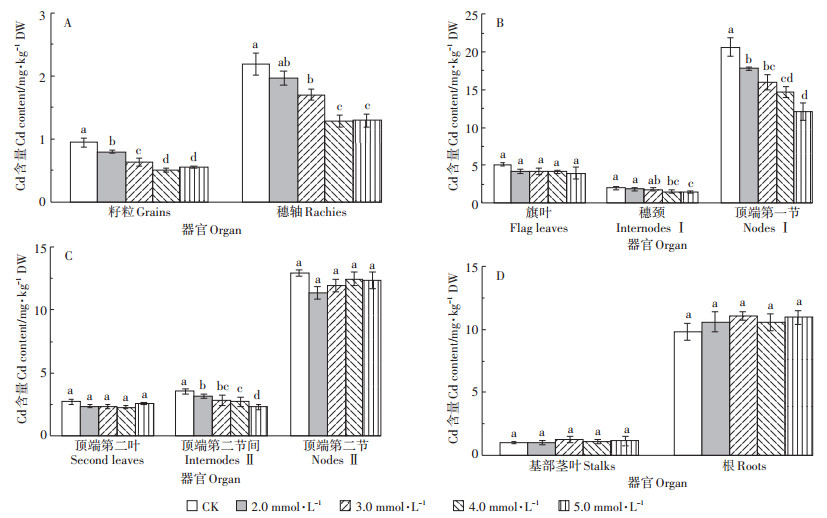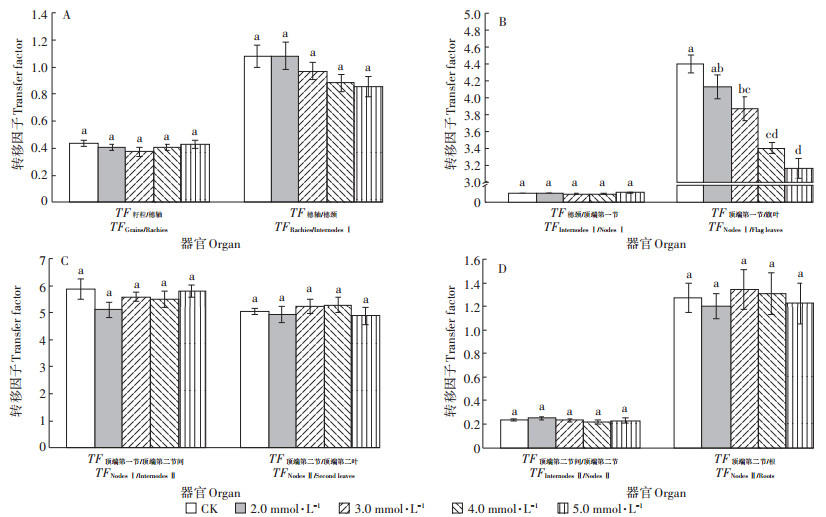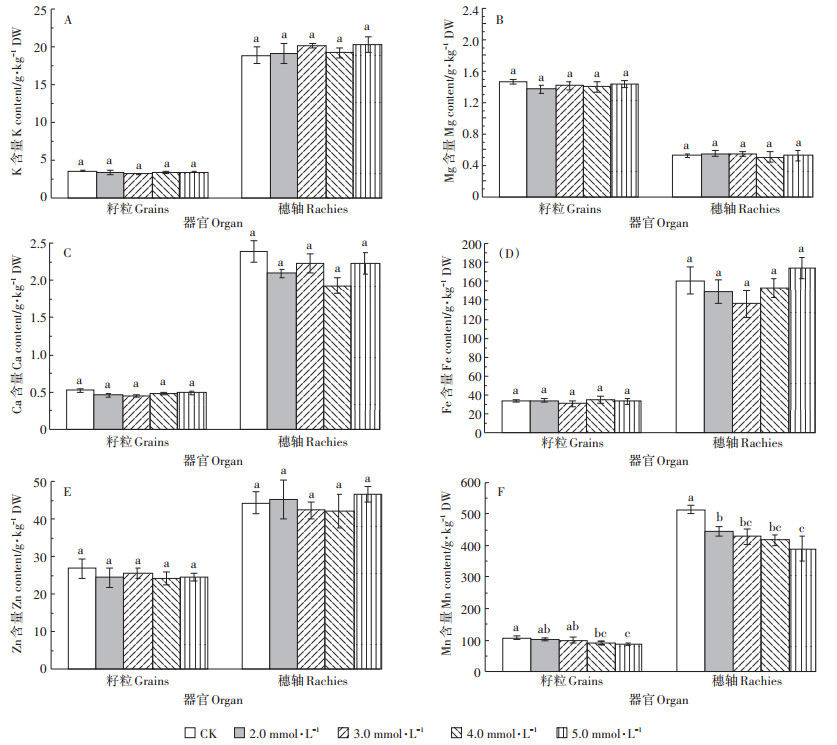镉(Cd)是一种对人体毒性较高的有害重金属元素[1]。由工、农业生产导致的环境污染,已经使我国有大约2.786×105 hm2的农用地受到Cd污染[2],耕地Cd污染点位超标率高达7%[3],农田Cd污染已成为重要的农业环境问题。水稻籽粒中的Cd主要来源于土壤[4],土壤轻度Cd污染即可导致稻米Cd含量超过国家食品安全限量标准[5],由食用稻米导致的Cd摄入量占我国人群Cd摄入量的56%[6]。由于土壤Cd污染的隐蔽性、累积性和长期性以及Cd在水稻中累积受其自身形态[7-9]、作物品种及生育期[10-11]等多种因素影响,我国大面积稻田Cd污染治理技术难度大,国内外至今仍缺乏成熟且能被大面积推广应用的修复技术[12-14]。因此,研发环境友好、农户可接受且易于大面积推广的农艺生产措施,对保障水稻安全生产具有重要意义。
Cd向水稻籽粒迁移转运的机制十分复杂。水稻通过木质部从根向茎转运Cd的能力是决定水稻茎秆中Cd积累浓度的主要影响因素[15]。Cd进入水稻茎、叶等组织后则主要通过韧皮部向水稻籽粒中转运,几乎100%的籽粒Cd来源于韧皮部运输[16-17]。在水稻开花期调控Cd经韧皮部向籽粒中转运是一种降低水稻籽粒Cd含量的重要途径。近年来,大量研究表明在水稻开花期喷施Si[18-19]、Se[20]、Zn[21]、Mn[22]等元素,可以显著降低Cd在水稻籽粒中的累积量。此外,在水稻开花期喷施小分子酸类物质也可以显著降低水稻籽粒中的Cd含量[23]。当前,在水稻开花期喷施叶面调理剂已成为一种降低水稻籽粒Cd含量的重要农艺措施,具有广泛的应用前景。
重金属螯合剂2,3-二巯基丁二酸(DMSA)分子中含有两个巯基,可以与多种有毒重金属如Cd2+、Pb2+、Hg2+等形成稳定的螯合物[24],在医疗上可以作为重金属中毒的解毒剂。该化合物具有水溶性较好、毒性低的特点,在全球范围内得到广泛应用[25]。本研究于水稻开花期叶面喷施一次DMSA以探索喷施DMSA调控水稻韧皮部Cd转运降低水稻籽粒中Cd含量的可行性,并探讨DMSA降低水稻籽粒中Cd含量的潜在机制。
1 材料与方法 1.1 试验材料与试验地点在湖南省湘阴县鹤龙湖镇黄花岭村选择土壤和稻米Cd含量均超标的水稻田进行试验。试验田土壤类型为水稻土,其基本理化性质为:pH 6.21,有机质40.83 g·kg-1,全氮0.173%,全磷0.019%,全钾1.3%,速效钾83.87 mg·kg-1,速效磷16.2 mg·kg-1,阳离子交换量18.92 cmol·kg-1,Cd 0.71 mg·kg-1,Mn 360.71 mg·kg-1,Zn 172.71 mg·kg-1。
以当地主栽品种黄花占为试验材料,种子购于当地种子公司。2,3-二巯基丁二酸(DMSA)购于国药集团,分析纯。
1.2 试验方法田间小区面积设定为10 m2(5 m×2 m)。试验小区共分1个对照处理组和3个试验处理组,每个处理组重复4次。将适量DMSA溶于1 mol·L-1的KOH溶液中,用田间灌溉水稀释至2 L,用0.5 mol·L-1的HCl调节pH为8.0~8.5,分别配制成2、3、4、5 mmol·L-1的DMSA水溶液。于水稻开花期向叶面手动均匀喷施处理液1次。对照组喷施2 L pH为8.0~8.5的田间灌溉水。
水稻采用旱育秧方式,于2018年7月18日移栽。施肥方法依照水稻测土配方施肥技术,每公顷施用尿素398 kg、钾肥210 kg,其中基肥占总施肥量的62%,分蘖肥占总量的29%,穗粒肥占总量的9%。整个生育期无显著病虫害发生。
1.3 样品的采集与处理于水稻成熟期,选取小区中心长3.0 m、宽1.5 m处喷施较为均匀部分,用铁锹每小区随机连根挖取3株水稻植株,装入网袋。常温自然风干后手动将水稻植株分为籽粒、穗轴、穗颈、旗叶、顶端第一节、顶端第二节、顶端第二叶、顶端第二节间、基部茎叶、根,共计10个部分。用蒸馏水漂洗3次后于70 ℃烘干72 h,凉却至室温后将各部分磨粉,分别收集到自封袋中,以备消解。
1.4 Cd及6种水稻矿质营养元素的测定方法参照Liu等[10]的方法,分别称取磨碎后的植株样品约0.25 g于消解管中,加入7 mL浓硝酸,摇匀,室温下静置12 h。将消解管放入电热消解仪上进行消解,110 ℃加热2.5 h后冷却至室温,再向消解管中加入1 mL H2O2摇匀,110 ℃继续加热1.5 h。将消解管内的液体于170 ℃下赶酸至0.5 mL以内,再将消解液稀释并转移至25 mL容量瓶内定容,用ICP-MS测定样品中Cd、K、Ca、Mg、Fe、Mn、Zn含量。本方法对7种元素的回收率为95%~105%,检出限为0.3~5.5 µg·kg-1。
1.5 数据统计及分析采用Microsoft Excel进行相关数据的计算、统计与处理。利用SPSS 17.0软件进行统计分析,新复极差法(Ducan′ s)进行多重比较、差异显著性检验。利用Origin 2018作图。
2 结果与分析 2.1 DMSA对水稻不同器官Cd含量的影响由图 1A可见,籽粒中Cd含量随着DMSA喷施浓度增加表现出显著的降低趋势,与对照相比籽粒中Cd含量降低幅度为15.84%~46.09%。但当DMSA使用浓度高于4 mol·L-1时,籽粒中Cd含量未表现出持续下降,表明继续增加DMSA用量已不能起到持续降低籽粒Cd含量的效果。穗轴Cd含量也表现出显著下降趋势,不同处理Cd降低幅度为10.03%~41.41%,同样当DMSA喷施浓度高于4 mol·L-1时穗轴中Cd含量也未出现持续降低现象。

|
图中不同小写字母表示处理间差异达到5%显著水平(n=4)。下同 Different lowercase letters indicate significant differences between different treatments at 5% level (n=4). The same below 图 1 喷施DMSA对水稻各器官中Cd含量的影响 Figure 1 Effects of foliar application of DMSA on Cd content in rice organs |
由图 1B可见,喷施DMSA后不同处理间旗叶中Cd含量与对照相比未出现显著差异,但是穗颈和顶端第一节中Cd含量出现显著降低,两种器官中Cd含量与对照相比的降低幅度为9.13%~28.46%和18.30~38.32%。
由图 1C可见,喷施DMSA后不同处理间顶端第二叶和顶端第二节中Cd含量与对照相比未出现显著差异,但是顶端第二节间Cd含量则呈现出随DMSA喷施浓度增加而显著降低的趋势,降低幅度为11.00%~34.76%。
由图 1D可见,喷施DMSA后不同处理间基部茎叶和根中Cd含量无显著差异。
2.2 喷施DMSA对水稻Cd转运系数的影响Cd在水稻不同器官中的浓度分布反应了其在水稻器官间的迁移能力,一般用转移系数来表示。转移系数为相邻器官间Cd含量的比值:

|
由图 2A可见,在水稻开花期叶面喷施一次DMSA后,Cd由穗颈向穗轴的转移系数(TF穗轴/穗颈)随着DMSA喷施浓度的增加表现出逐渐降低的趋势,但不同处理间转移系数的差异尚未达到显著水平。由图 2B可见,当喷施DMSA后,Cd由旗叶向顶端第一节的转移系数发生了显著变化,随着DMSA喷施浓度的增加,Cd由旗叶向顶端第一节的转移系数(TF顶端第一节/旗叶)呈显著降低趋势,表明喷施DMSA减少了Cd由旗叶向顶端第一节的转运。开花期喷施DMSA对Cd在其他器官间的转移系数没有显著改变,表明喷施DMSA对Cd在其他器官间的迁移转运没有显著影响。

|
图 2 喷施DMSA对水稻各器官间转移系数的影响 Figure 2 Effects of foliar application of DMSA on the transfer factors between rice organs |
水稻开花期叶面喷施一次DMSA对水稻籽粒和穗轴中的矿质元素含量影响如图 3所示。由图 3A至图 3E可见,喷施DMSA对水稻籽粒和穗轴中的K、Mg、Ca、Fe、Zn含量的影响不大,4个处理中矿质元素含量与对照相比未形成显著差异。但是,喷施高浓度DMSA对籽粒和穗轴中的Mn含量造成显著影响(图 3F),与对照组相比喷施DMSA导致籽粒和穗轴中Mn含量分别降低5.79%~17.87%和13.51%~24.21%,表明水稻开花期叶面喷施DMSA影响了Mn向水稻籽粒中的转运。

|
图 3 喷施DMSA对水稻籽粒和穗轴矿质元素含量的影响 Figure 3 Effects of foliar application of DMSA on mineral elements concentration in grains and rachises |
动物实验表明,DMSA在体内通过分子中含有的两个巯基与Cd形成稳定的螯合物,最终以螯合态排出体外从而达到降低Cd毒性的目的[24-25]。有研究表明,Cd在水稻韧皮部伤流液中大部分与蛋白类、植物螯合素等物质以结合态存在,小部分以离子形式存在[26]。蛋白螯合态的Cd并非一种稳定形态,当遇到蛋白激酶后又会重新释放出Cd2+。当DMSA进入水稻体内后可与Cd2+竞争性结合形成螯合物。植物自身也可合成多种含有巯基的解毒化合物如PCs[27]、谷胱甘肽等[28],它们都可以与Cd2+形成稳定的化合物并储存在植物液泡等器官中[29],不仅降低了Cd对植物的胁迫效应,而且在一定程度上也降低了Cd向地上部的转运。据此推断,在水稻开花期叶面喷施DMSA主要是通过与水稻叶片等组织中的Cd2+形成螯合物来降低Cd向籽粒中的转运。可见,喷施DMSA降低籽粒中Cd含量的机制与喷施Zn2+[21]、Mn2+[22]等通过离子拮抗降低Cd向水稻籽粒中转运导致籽粒中Cd含量降低的机制有所不同,也与喷施Si[18]增加水稻茎和叶片细胞壁固持Cd能力从而降低Cd向籽粒转运的机制不同。为降低水稻籽粒中Cd含量,育种学家引入了基因编辑技术。当敲除负责调控水稻转运Cd和Mn的Nramp5基因[30]后,无论是粳稻还是籼稻籽粒中Cd和Mn的浓度都出现大幅度降低,其中Mn浓度可下降80%以上[31-32]。在本研究中,喷施DMSA对水稻籽粒和穗轴中必需营养元素K、Mg、Ca、Fe、Zn的含量没有显著影响,但是在降低籽粒中Cd含量的同时也显著降低了籽粒中Mn的浓度。喷施DMSA是否影响了Nramp5等基因的表达仍有待进一步研究。
关于水稻籽粒中Cd的来源日本学者给出了相互矛盾的结论。Fujimaki等[33]利用107Cd同位素示踪技术的研究结果表明,在灌浆期水稻从土壤中吸收的Cd被运送到籽粒;Kashiwagi等[34]的研究结果表明水稻籽粒中Cd主要来自于抽穗前累积在叶片和茎秆中的Cd,抽穗后从根运送到茎秆和穗部的Cd不影响糙米中Cd的累积。喻华等[11]进一步研究表明,在田间水稻齐穗后土壤中有效Cd含量较低时,籽粒中的Cd同时来自于土壤和水稻体内在齐穗前累积的Cd。叶片是向籽粒净转移Cd的主要器官,叶片衰老期Cd通过韧皮部向籽粒转移是Cd再分配的主要过程[35]。在本研究中,随着DMSA喷施浓度增加水稻籽粒中Cd含量呈现出显著降低趋势,最高降幅达到46.09%(图 1A),而旗叶中Cd含量则未出现显著降低(图 1B),表明喷施DMSA降低了旗叶中Cd经顶端第一节向籽粒的转运,对水稻籽粒Cd含量的降低具有较大贡献。Feng等[36]的研究表明,水稻的根和节是Cd进入水稻地上部的主要障碍,这两个部位的Cd含量最高,当外界有效Cd含量较低时,进入水稻体内的大部分Cd被固定到这两个部位,这时水稻器官中Cd的再转运成为籽粒中Cd的主要来源。在本研究中开花期喷施DMSA显著降低了顶端第一节中Cd的含量(图 1B),此现象与喷施纳米硅[19]降低籽粒Cd含量的现象一致,表明顶端第一节中Cd含量的降低对籽粒Cd降低也具有较大贡献。
当开花期叶面喷施DMSA后,显著降低了Cd由旗叶向顶端第一节的转移系数(图 2B)。同时Cd由穗颈向穗轴的转移系数(图 2A)也出现降低趋势但并未达到显著程度,其他器官中Cd的转移系数并未见发生显著变化。此结果与喷施DMSA后水稻叶片中Cd含量未见显著变化相互印证。说明喷施DMSA影响籽粒中Cd含量降低的主要因素是降低了叶片Cd向籽粒的输送。
DMSA对人体的毒性较低,可以在医疗上作为人体Cd、As、Pb、Hg等[24-25]重金属中毒后的解毒剂,因此其对人体的安全性很高。目前,利用DMSA阻控Cd向水稻籽粒中转运的研究鲜有报道,同时也未见DMSA是否对植物生长有负面影响的报道。本研究中同时开展了喷施DMSA对水稻产量影响的研究,稻谷产量与对照相比未见显著差异(本文未提供具体数据)。当DMSA的喷施浓度超过4 mmol·L-1时水稻籽粒和穗轴中Cd含量并未出现持续降低(图 1A),此结果为农业生产实践中DMSA的实际用量提供了指导。
4 结论(1)在水稻开花期叶面喷施DMSA可以显著降低籽粒中Cd含量。田间试验表明,喷施一次DMSA使籽粒中Cd最高降幅可达46.09%。
(2)旗叶Cd向顶端第一节中的迁移率降低对籽粒Cd含量降低有较大贡献。喷施DMSA显著降低了Cd由旗叶向顶端第一节中的迁移系数,表明与对照相比旗叶中Cd向籽粒中转运量显著减少。
(3)巯基化合物DMSA是一种潜在的降Cd叶面调理剂,具有较好的应用前景。
| [1] |
Rizwan M, Ali S, Akbar M Z, et al. Foliar application of aspartic acid lowers cadmium uptake and Cd-induced oxidative stress in rice under Cd stress[J]. Environmental Science and Pollution Research, 2017, 24(27): 21938-21947. DOI:10.1007/s11356-017-9860-1 |
| [2] |
Liu F, Liu X N, Ding C, et al. The dynamic simulation of rice growth parameters under cadmium stress with the assimilation of multi-period spectral indices and crop model[J]. Field Crops Research, 2015, 183: 225-234. DOI:10.1016/j.fcr.2015.08.004 |
| [3] |
陈能场, 郑煜基, 何晓峰, 等. 《全国土壤污染状况调查公报》探析[J]. 农业环境科学学报, 2017, 36(9): 1689-1692. CHEN Neng-chang, ZHENG Yu-ji, HE Xiao-feng, et al. Analysis of the Report on the National General Survey of Soil Contamination[J]. Journal of Agro-Environment Science, 2017, 36(9): 1689-1692. |
| [4] |
Uraguchi S, Kamiya T, Sakamoto T, et al. Low-affinity cation transporter(OsLCT1)regulates cadmium transport into rice grains[J]. Proceedings of the National Academy of Sciences of the United States of America, 2011, 108(52): 20959-20964. DOI:10.1073/pnas.1116531109 |
| [5] |
中华人民共和国国家卫生和计划生育委员会国家食品药品监督管理总局.食品安全国家标准食品中污染物限量GB 2762-2017[S].北京: 中国标准出版社, 2017. State Food and Drug Administration of the National Health and Family Planning Commission of the People's Republic of China. National food safety standards for food contaminants GB 2762-2017[S]. Beijing: China Standards Press, 2017. |
| [6] |
Song Y, Wang Y, Mao W, et al. Dietary cadmium exposure assessment among the Chinese population[J]. PLoS One, 2017, 12(5): 1-12. |
| [7] |
Kosolsaksakul P, Farmer J G, Oliver I W, et al. Geochemical associations and availability of cadmium(Cd)in a paddy field system, northwestern Thailand[J]. Environmental Pollution, 2014, 187: 153-161. DOI:10.1016/j.envpol.2014.01.006 |
| [8] |
Clemens S, Ma J F. Toxic heavy metal and metalloid accumulation in crop plants and foods[J]. Annual Review of Plant Biology, 2016, 67(1): 489-512. DOI:10.1146/annurev-arplant-043015-112301 |
| [9] |
王梦梦, 何梦媛, 苏德纯. 稻田土壤性质与稻米镉含量的定量关系[J]. 环境科学, 2018, 39(4): 1918-1925. WANG Meng-meng, HE Meng-yuan, SU De-chun. Quantitative relationship between paddy soil properties and cadmium content in rice grains[J]. Environmental Science, 2018, 39(4): 1918-1925. |
| [10] |
Liu Y, Zhang C, Zhao Y, et al. Effects of growing seasons and genotypes on the accumulation of cadmium and mineral nutrients in rice grown in cadmium contaminated soil[J]. Science of the Total Environment, 2017, 579: 1282-1288. DOI:10.1016/j.scitotenv.2016.11.115 |
| [11] |
喻华, 上官宇先, 涂仕华, 等. 水稻籽粒中镉的来源[J]. 中国农业科学, 2018, 51(10): 1940-1947. YU Hua, SHANGGUAN Yu-xian, TU Shi-hua, et al. Sources of cadmium accumulated in rice grain[J]. Scientia Agricultura Sinica, 2018, 51(10): 1940-1947. DOI:10.3864/j.issn.0578-1752.2018.10.013 |
| [12] |
于焕云, 崔江虎, 乔江涛, 等. 稻田镉砷污染阻控原理与技术应用[J]. 农业环境科学学报, 2018, 37(7): 1418-1426. YU Huan-yun, CUI Jiang-hu, QIAO Jiang-tao, et al. Principle and technique of arsenic and cadmium pollution control in paddy field[J]. Journal of Agro-Environment Science, 2018, 37(7): 1418-1426. |
| [13] |
Chen H, Zhang W, Yang X, et al. Effective methods to reduce cadmium accumulation in rice grain[J]. Chemosphere, 2018, 207: 699-707. DOI:10.1016/j.chemosphere.2018.05.143 |
| [14] |
李义纯, 王艳红, 唐明灯, 等. 改良剂对根际土壤-水稻系统中镉运移的影响[J]. 环境科学, 2019. LI Yi-chun, WANG Yan-hong, TANG Ming-deng, et al. Effects of an amendment on cadmium transportation in rhizosphere soil-rice system[J]. Environmental Science, 2019. DOI:10.13227/j.hjkx.201811016.hjkx.201811016 |
| [15] |
Uraguchi S, Mori S, Kuramata M, et al. Root-to-shoot Cd translocation via the xylem is the major process determining shoot and grain cadmium accumulation in rice[J]. Journal of Experimental Botany, 2009, 60(9): 2677-2688. DOI:10.1093/jxb/erp119 |
| [16] |
Fujimaki S, Suzui N, Ishioka N S, et al. Tracing cadmium from culture to spikelet:Noninvasive imaging and quantitative characterization of absorption, transport, and accumulation of cadmium in an intact rice plant[J]. Plant Physiology, 2010, 152(4): 1796-1806. |
| [17] |
Tanaka K, Fujimaki S, Fujiwara T, et al. Quantitative estimation of the contribution of the phloem in cadmium transport to grains in rice plants(Oryza sativa L.)[J]. Soil Science Plant and Nutrition, 2007, 53(1): 72-77. DOI:10.1111/j.1747-0765.2007.00116.x |
| [18] |
Liu C P, Li F B, Luo C L, et al. Foliar application of two silica sols reduced cadmium accumulation in rice grains[J]. Journal of Hazardous Materials, 2009, 161(2/3): 1466-1472. |
| [19] |
Chen R, Zhang C B, Zhao Y L, et al. Foliar application with nano-silicon reduced cadmium accumulation in grains by inhibiting cadmium translocation in rice plants[J]. Environmental Science and Pollution Research, 2018, 25(3): 2361-2368. DOI:10.1007/s11356-017-0681-z |
| [20] |
Gao M, Zhou J, Liu H L, et al. Foliar spraying with silicon and selenium reduces cadmium uptake and mitigates cadmium toxicity in rice[J]. Science of the Total Environment, 2018, 631/632: 1100-1108. DOI:10.1016/j.scitotenv.2018.03.047 |
| [21] |
吕光辉, 许超, 王辉, 等. 叶面喷施不同浓度锌对水稻锌镉积累的影响[J]. 农业环境科学学报, 2018, 37(7): 1521-1528. LÜ Guang-hui, XU Chao, WANG Hui, et al. Effect of foliar spraying zinc on the accumulation of zinc and cadmium in rice[J]. Journal of Agro-Environment Science, 2018, 37(7): 1521-1528. |
| [22] |
尹晓辉, 邹慧玲, 方雅瑜, 等. 施锰方式对水稻吸收积累镉的影响研究[J]. 环境科学与技术, 2017, 40(8): 8-12. YIN Xiao-hui, ZOU Hui-ling, FANG Ya-yu, et al. Effects of manganese fertilizer on absorption and accumulation of Cd in rice[J]. Environmental Science & Technology, 2017, 40(8): 8-12. |
| [23] |
张烁, 陆仲烟, 唐琦, 等. 水稻叶面调理剂的降Cd效果及其对营养元素转运的影响[J]. 农业环境科学学报, 2018, 37(11): 2507-2513. ZHANG Shuo, LU Zhong-yan, TANG Qi, et al. Effects of foliar modulators on cadmium accumulation and transport of nutrient elements in rice[J]. Journal of Agro-Environment Science, 2018, 37(11): 2507-2513. DOI:10.11654/jaes.2018-0864 |
| [24] |
Miller A L. Dimercaptosuccinic acid(DMSA), a non-toxic, water-soluble treatment for heavy metal toxicity[J]. Alternative Medicine Review, 1998, 3(3): 199-207. |
| [25] |
Chisolm J J. Safety and efficacy of meso-2,3-dimercaptosuccinic acid (DMSA)in children with elevated blood lead concentrations[J]. Journal of Toxicology. Clinical Toxicology, 2000, 38(4): 365-2375. DOI:10.1081/CLT-100100945 |
| [26] |
Kato M, Ishikawa S, Inagaki K, et al. Possible chemical forms of cadmium and varietal differences in cadmium concentrations in the phloem sap of rice plants[J]. Soil Science and Plant Nutrition, 2010, 56: 839-847. DOI:10.1111/j.1747-0765.2010.00514.x |
| [27] |
罗洁文, 李莹, 苏烁烁, 等. 类芦根系抗氧化酶和植物螯合肽对Cd、Pb胁迫的应答[J]. 生态环境学报, 2016, 25(6): 1047-1053. LUO Jie-wen, LI Ying, SU Shuo-shuo, et al. Response of antioxidant enzymes and PCs in root of neyraudia-reynaudiana to Cd, Pb stress[J]. Ecology and Environment Sciences, 2016, 25(6): 1047-1053. |
| [28] |
冯倩, 台培东, 付莎莎, 等. 巯基化合物在万寿菊镉解毒中的作用[J]. 环境工程学报, 2010, 4(1): 214-218. FENG Qian, TAI Pei-dong, FU Sha-sha, et al. The role of thiol pool in cadmium detoxification in marigold plants[J]. Chinese Journal of Environmental Engineering, 2010, 4(1): 214-218. |
| [29] |
Martinoia E, Grill E, Tommasini R. ATP-dependent glutathione Sconjugate 'export' pump in the vacuolar membrane of plants[J]. Nature, 1993, 364: 247-249. DOI:10.1038/364247a0 |
| [30] |
Sasaki A, Yamaji N, Yokosho K, et al. Nramp5 is a major transporter responsible for manganese and cadmium uptake in rice[J]. The Plant Cell, 2012, 24(5): 2155-2167. |
| [31] |
Ishikawa S, Ishimaru Y, Igura M, et al. Ion-beam irradiation, gene identification, and marker-assisted breeding in the development of low-cadmium rice[J]. Proceedings of the National Academy of Sciences of the United States of America, 2012, 109(47): 19166-19171. DOI:10.1073/pnas.1211132109 |
| [32] |
Tang L, Mao B G, Li Y K, et al. Knockout of OsNramp5 using the CRISPR/Cas9 system produces low Cd-accumulating indica rice without compromising yield[J]. Scientific Reports, 2017, 7: 14438. DOI:10.1038/s41598-017-14832-9 |
| [33] |
Fujimaki S, Suzui N, Ishioka N S, et al. Tracing cadmium from culture to spikelet:Noninvasive imaging and quantitative characterization of absorption, transport, and accumulation of cadmium in an intact rice plant[J]. Plant Physiology, 2010, 152(4): 1796-1806. DOI:10.1104/pp.109.151035 |
| [34] |
Kashiwagi T, Shindoh K, Hirotsu N, et al. Evidence for separate translocation pathways in determining cadmium accumulation in grain and aerial plant in rice[J]. BMC Plant Biology, 2009, 9: 8. DOI:10.1186/1471-2229-9-8 |
| [35] |
Yan Y F, Chio D W, Kim D, et al. Absorption, translocation, and remobilization of cadmium supplied at different growth stages of rice[J]. Journal of Crop Science & Biotechnology, 2010, 13(2): 113-119. |
| [36] |
Feng X M, Han L, Chao D Y, et al. Ionomic and transcriptomic analysis provides new insight into the distribution and transport of cadmium and arsenic in rice[J]. Journal of Hazardous Materials, 2017, 331: 246-256. DOI:10.1016/j.jhazmat.2017.02.041 |
 2019, Vol. 38
2019, Vol. 38


